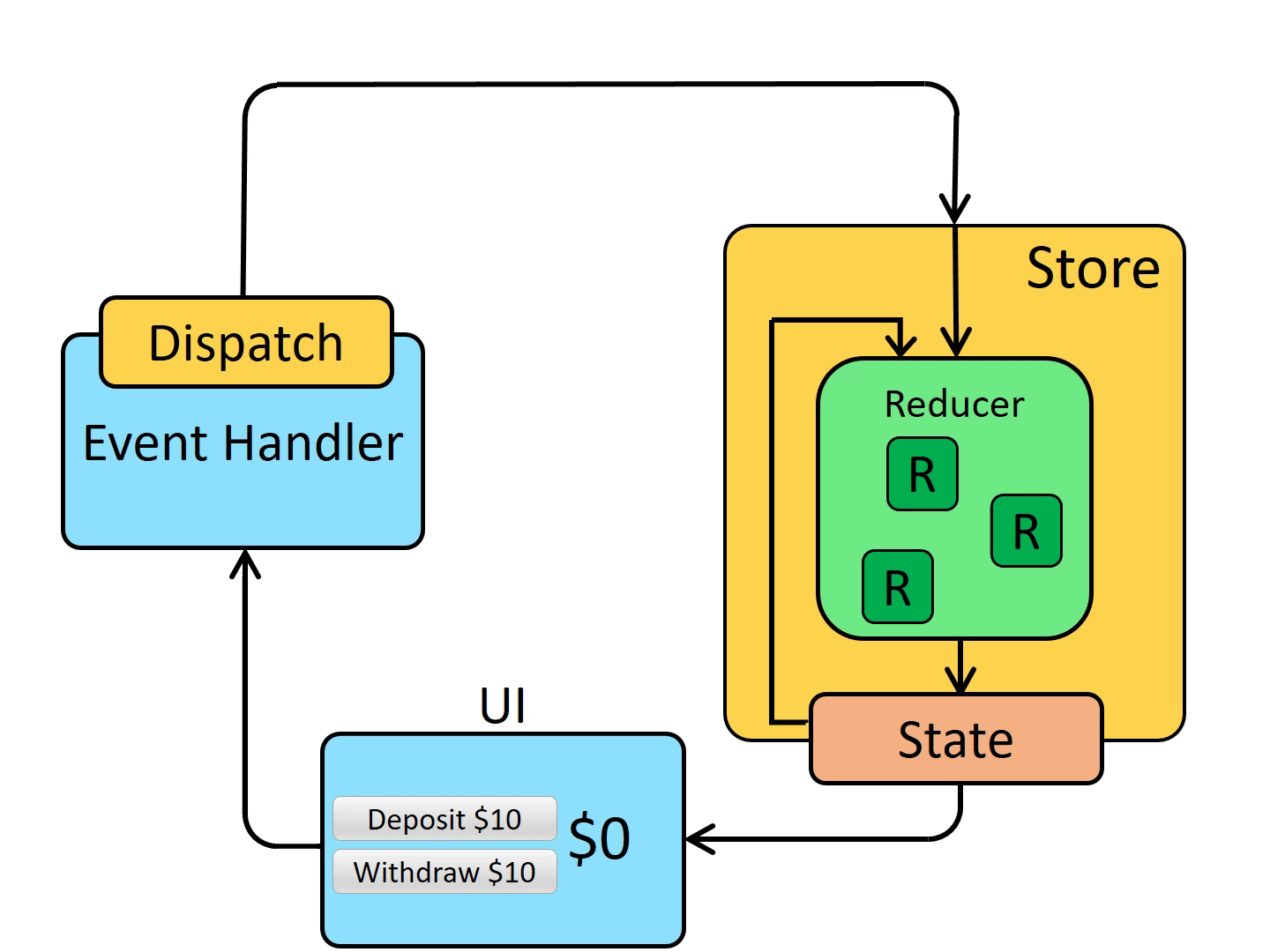Redux - Core concepts & Example
이전 문서에서 Redux의 역사와 사용목적에 대해 알아보았다. 이번 문서에서는 Redux의 핵심 개념과 예제를 통해 Redux의 작동 원리를 알아보자.
Redux 맛보기
<!DOCTYPE html>
<html>
<head>
<title>Redux basic example</title>
</head>
<body>
<div>
<p>
Clicked: <span id="value">0</span> times
<button id="increment">+</button>
<button id="decrement">-</button>
<button id="incrementIfOdd">Increment if odd</button>
<button id="incrementAsync">Increment async</button>
</p>
</div>
<script type="module">
import { createStore } from "https://unpkg.com/redux@latest/dist/redux.browser.mjs";
// 초기값을 정의합니다.
const initialState = {
value: 0
};
// 새로운 state가 어떻게 동작할지 정의합니다.
// 리듀서는 액션이 발생했을 때 어떻게 상태를 업데이트할지 결정합니다.
function counterReducer(state = initialState, action) {
// 리듀서는 일반적으로 발생하는 액션의 타입을 정의하고 어떻게 동작할지 결정합니다. (switch case를 잘봐주세요)
switch (action.type) {
case "counter/incremented":
return { ...state, value: state.value + 1 };
case "counter/decremented":
return { ...state, value: state.value - 1 };
default:
return state;
}
}
// 리덕스의 state를 저장하는 'store'를 생성합니다. 그리고 리듀서를 통해 상태를 업데이트합니다.
const store = createStore(counterReducer);
// UI를 업데이트할 DOM 요소를 찾습니다.
const valueEl = document.getElementById("value");
// Whenever the store state changes, update the UI by
// reading the latest store state and showing new data
function render() {
// store의 state를 가져옵니다.
const state = store.getState();
valueEl.innerHTML = state.value.toString();
}
// Update the UI with the initial data
render();
// And subscribe to redraw whenever the data changes in the future
store.subscribe(render);
// Handle user inputs by "dispatching" action objects,
// which should describe "what happened" in the app
document
.getElementById("increment")
.addEventListener("click", function () {
store.dispatch({ type: "counter/incremented" });
});
document
.getElementById("decrement")
.addEventListener("click", function () {
store.dispatch({ type: "counter/decremented" });
});
document
.getElementById("incrementIfOdd")
.addEventListener("click", function () {
// We can write logic to decide what to do based on the state
if (store.getState().value % 2 !== 0) {
store.dispatch({ type: "counter/incremented" });
}
});
document
.getElementById("incrementAsync")
.addEventListener("click", function () {
// We can also write async logic that interacts with the store
setTimeout(function () {
store.dispatch({ type: "counter/incremented" });
}, 1000);
});
</script>
</body>
</html>
위 코드가 리덕스가 작동하는 방식의 전부다. 리덕스는 독립된 js 라이브러리임을 강조하고자 위의 예시코드를 작성하였다. 리덕스는 단순한 컨셉을 가지고 있으며, 이를 통해 상태를 예측 가능하고 유지보수가 쉽게 관리할 수 있다. 이제부터 하나하나 파헤쳐보자.
Redux Core Concepts
배울 개념
- Store
- Reducer
- Action
- Dispatch
Redux 데이터 바인딩 흐름
리덕스는 이하와 같이 state를 단방향의 흐름으로 관리한다.

- Redux의
Store와Reducer를 정의합니다. - 사용자의 동작에 의해
Dispatch를 통해Action을 스토어에 전송합니다. Reducer는Action과 이전State를 기반으로State를 업데이트합니다.Store는 업데이트된State를Subscribe한 컴포넌트에 전달합니다.- 컴포넌트는 업데이트된
State를 통해 UI를 업데이트합니다(render는 별도).
Store 정의하기 (opens in a new tab)
Store는 애플리케이션의 상태를 저장하는 객체이다. Store는 직접 수정할 수 없으며 dispatch를 통해 action을 전달하여 Reducer로 상태를 변경할 수 있다. 또한, 애플리케이션에 단 하나의 루트 스토어가 존재한다.
createStore(리듀서): Store를 생성하는 함수
import { createStore } from "https://unpkg.com/redux@latest/dist/redux.browser.mjs";
const store = createStore(counterReducer);Reducer 정의하기 (opens in a new tab)
Reducer는 애플리케이션의 상태를 변경하는 함수이다. Redux는 실제로 단 하나의 Reducer 함수만 가지고 있습니다. Reducer는 이전 상태와 액션을 받아 새로운 상태를 반환한다. Reducer는 순수 함수로 작성되어야 하며, 이전 상태를 변경하지 않고 새로운 상태를 복사한다(immutable updates).
- 순수 함수(예측 가능한)로 Root Reducer를 작성하기
- action의
type을 기반으로 액션을 분기하여 상태를 업데이트하기 - Slice 패턴을 활용하여 특정 기능의 Reducer를 분리하고, 합칠 수 있다
const initialState = {
value: 0
};
function counterReducer(state = initialState, action) {
switch (action.type) {
case "counter/incremented":
return { ...state, value: state.value + 1 };
case "counter/decremented":
return { ...state, value: state.value - 1 };
default:
return state;
}
}Action 정의하기
Action은 상태를 변경의 맥락을 담은 일종의 주문서이다. type을 필수로 가지며, payload를 통해 추가적인 데이터를 전달할 수 있다.
type: 액션의 종류를 나타내는 문자열payload: 액션과 함께 전달되는 데이터
{ type: "counter/incremented" }
{ type: "counter/decremented" }
{ type: "counter/incremented" }
{ type: "counter/incremented" }
// payload를 사용하는 경우
{ type: "counter/incremented", payload: 10 }Dispatch 정의하기
Dispatch는 Action을 Reducer로 전달하는 함수이다. Dispatch를 통해 Action을 전달하면 Reducer가 이를 받아 상태를 업데이트한다.
store.dispatch(action): Action을 Reducer로 전달하는 함수
store.dispatch({ type: "counter/incremented" });State를 가져오기
위에 정리된 내용을 통해 Store에 상태를 업데이트하였다. 이제 Store를 구독하고 업데이트된 State를 가져와 UI를 업데이트하자.
store.subscribe(callback): Store를 구독하는 함수store.getState(): Store의 상태를 가져오는 함수
function render() {
const state = store.getState();
valueEl.innerHTML = state.value.toString();
}
store.subscribe(render);Summary
- Store에 상태를 저장하고, Reducer를 통해 상태를 업데이트한다.
- Action을 Dispatch를 통해 Reducer로 전달한다.
- Reducer는 Action의 type을 기반으로 상태를 업데이트한다.
- Store를 구독하고 업데이트된 State를 가져와 UI를 업데이트한다.
Redux의 단방향 상태관리의 핵심 개념과 예제 코드를 통해 Redux의 작동 원리를 알아보았다. 리덕스의 코어 개념만 작성하였기에 Slice 패턴을 활용하여 특정 기능을 하는 Reducer를 분리한다던가 Redux 공식 Docs에서 권장하는 RTK는 무엇이며, 리액트 환경에 적합한 React-Redux, 비동기 처리에서는 Redux-thunk로 복잡한 상태관리를 어떤방식으로 해결하였는지는 이후 문서에서 정리하도록 하자.
참고 자료
- Redux 공식문서 - Redux Fundamentals, Part 2: Concepts and Data Flow (opens in a new tab)
- Redux 공식문서 - Redux Fundamentals, Part 3: State, Actions, and Reducers (opens in a new tab)
- Redux 공식문서 - Three Principles (opens in a new tab)
다음 글 읽으러 가기 →